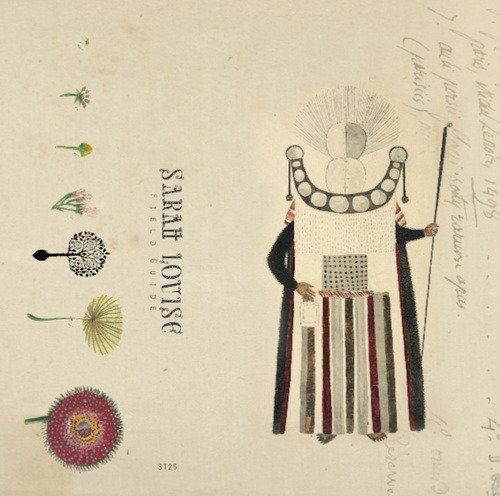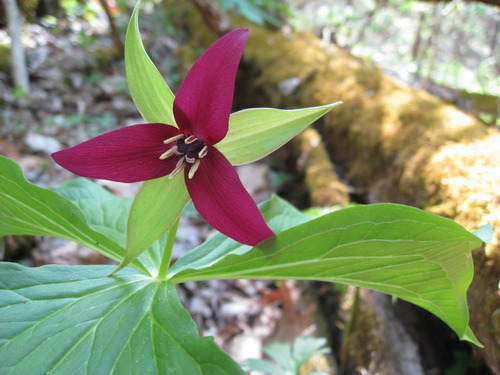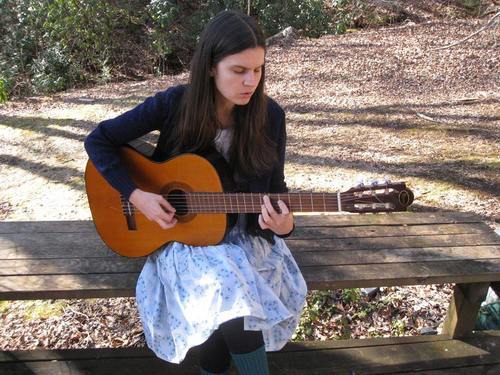A couple of weeks ago we wrote about Field Guide, a really great album from North Carolina native Sarah Louise. Despite being entirely instrumental, the album is incredibly deep. As we said in our review, “Louise manages to circumvent the skin-deep and decidedly human introspection that occupies most genres in favour of something larger and wider, resonating on a deeper level. The songs speak of an association with nature that makes everything else appear incidental, a connection that humanity has attempted to sever for millennia without ever quite succeeding. In this way the album is both sad and joyous, a reminder of all we have missed and all there is left to experience, the terrifying, heartbreaking and glorious comfort that we, as humans, are an oh-so-small part of an oh-so-wonderful world”.

Luckily for us, Sarah agreed to discuss Field Guide with us, and her answers to our questions explore the album’s themes and inspirations far better than we ever could.
Hello Sarah, I hope you are well! How is life in North Carolina this time of year?
Life is good! In some ways the tail end of Winter is the sweetest time of year because I know there is so much amazing weather ahead of me!
It’s clear that Field Guide is influenced heavily by the natural world. Would you say that nature plays a big role in your life and creative process?
I’m so glad that comes across. Nature is the most constant interest I have had in my life. Even when I was little I felt so bonded to it. I would literally read and memorize field guides, a pastime which still serves me well in my life in the mountains of North Carolina. It’s medicine for me and my greatest source of inspiration.
The other big influence is traditional folk music. How much has this shaped your music? I’m not a specialist in the taxonomy of traditional music but is there a particular branch that you see yourself aligned to?
I’ve enjoyed the diversity of American traditional music for long enough that it is in my DNA and peeks out when it wants to. However, I wrote a couple of the songs on “Field Guide” around two specific lined-out hymns. I thought of my interaction with the material as a way of honouring these amazing women of song,like placing flowers around a sacred object. In some of the songs on “Field Guide” I was dealing with similarities between Appalachian music and Hindustani and Carnatic music. For example, harmony was not allowed in some of the more
conservative southern churches and was instead replaced by drones, rich melodies and melisma. These characteristics are also hallmarks of Indian music, as well as many other kinds of traditional music from around the world. To me, these connections speak to the ancientness of some of these mountain melodies (although I can’t prove their origins). I certainly don’t want to reduce the complexities or distinctiveness of these individual traditions, but I find inspiration in the similarities.
*Here are traditional recordings of the lined out hymns that Sarah mentions above, and I’ve included her guitar versions so you can compare and contrast. First is ‘The Day is Past and Gone’ by Jean Ritchie:
[soundcloud url=”https://api.soundcloud.com/tracks/195220601″ params=”color=ff5500&auto_play=false&hide_related=false&show_comments=true&show_user=true&show_reposts=false” width=”100%” height=”166″ iframe=”true” /]
[soundcloud url=”https://api.soundcloud.com/tracks/190324384″ params=”color=ff5500&auto_play=false&hide_related=false&show_comments=true&show_user=true&show_reposts=false” width=”100%” height=”166″ iframe=”true” /]
…and secondly ‘A Home Just Over Yonder’ by Frankie Duff:
[soundcloud url=”https://api.soundcloud.com/tracks/195220600″ params=”color=ff5500&auto_play=false&hide_related=false&show_comments=true&show_user=true&show_reposts=false” width=”100%” height=”166″ iframe=”true” /]
[soundcloud url=”https://api.soundcloud.com/tracks/195223571″ params=”color=ff5500&auto_play=false&hide_related=false&show_comments=true&show_user=true&show_reposts=false” width=”100%” height=”166″ iframe=”true” /]
It’s not that difficult to notice that the album isn’t a completely happy one, that’s not to say it doesn’t have little bright moments of joy, but it has varying shades of emotion, and sadness is certainly well-represented. This captures perfectly my feelings on nature – namely that it is an incomprehensibly amazing thing, but something facing the dire consequences of us as a species. Did you set out to write something that touched upon not only the joy of natureitself but also the sad fact that so many people are now disconnected from it?
What’s interesting about writing music for me is that sometimes when I am sad, I write joyful-sounding music, and sometimes when I am joyful, melancholy will emerge in a piece. I think that speaks to music’s wideness and strength as an expressive medium that goes beyond language or individual emotions. I didn’t set out to have “Field Guide” express sadness or joy about a particular topic, although it is safe to say that some of my deepest sadness stems from my concern about our culture’s disconnection from nature and the empty consumerism that can follow. And my greatest moments of joy are often in the woods, making little discoveries or feeling connected to the life around me.
*We asked Sarah to share a photograph that sums up Field Guide for her. It was an impossible question and she admitted defeat, but did share this picture of a Wake Robin, a species from the genus Trillium, which is one of her favourite wildflowers native to North Carolina.*

The music on Field Guide feels old – if you played it to a random sample of the general public, I reckon lots of them would place it somewhere in the formative years of the previous century – is that something you set out to achieve, this timeless quality, or is it more a consequence of your inspiration/influences?
It wasn’t an intention to write something that sounded timeless, but I just tried to be as honest and exploratory during my process as I could be. I have never wanted to write music that sounded like anyone else, but it makes me feel good that you think it sounds timeless. Thank you!
Does the album also have a more intimate, personal scope? Track titles like ‘Dog Improv’ and ‘Late Summer Seed Collection’ seem to suggest that the album as also inspired by personal memories.
Some of the titles are definitely inspired by my memories. I kept a seed collection when I was a kid in a large file drawer, which I lovingly labeled and alphabetized. And I still save seeds from/for my garden! The origin of the music itself is more difficult to pin down. I don’t know exactly where it comes from. I’m glad it’s a little bit mysterious.

This new version of Field Guide is entirely instrumental. Was this a conscious choice for this release or did the songs naturally take that direction? How do you decide when to include vocals on your tracks?
I always aim to have my pieces function first and foremost as instrumentals. In most cases I have added vocals only once the guitar part is finished. I’m starting to explore the possibility of writing instrumental and vocal parts simultaneously as a way to shake-up my process if nothing else. Scissor Tail Editions releases almost exclusively instrumental music, and since the pieces for the most part already functioned without vocals, it felt fine to cut them.
Could you list four or five artists/bands you really like and think people should hear? They could be new or not so new or one hundred years dead, whatever you like.
Asheville, North Carolina has a stellar scene, particularly for guitar music. Shane Parish
has a new tape out on Marmara Records called “Odei”, which is incredible for its inventiveness and is an absolute pleasure to listen to. I’m also a huge fan of Tashi Dorji who can say more in 3 seconds worth of guitar than many, many words could express. He has an upcoming album on Asheville-based Bathetic Records. Wes Tirey, who I think you’ve also featured (J: yes we have), is a Scissor Tail alum and a great player/songster (and has new tape out on Cabin Floor Esoterica). And my friend Emmalee Hunnicutt is a hypnotic, soulful cello composer who also collaborates with Shane Parish. That better be the last one or I won’t know where to stop!

